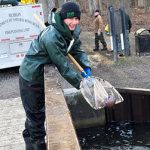GREAT LAKES, Mich. (WLUC) – If you’re at a Great Lakes port this season, you might see one of the Michigan Department of Natural Resources’ large fisheries research vessels conducting annual fish surveys.
The public is encouraged to visit the vessels when in port and talk with the crews about their work. To ensure the safety of all, anglers and boaters are asked to give research vessels and their deployed sampling gear plenty of space when on the water.
“The staff on these vessels are working on a wide variety of studies to better understand Great Lakes fish communities, population sizes and habitats,” said Gary Whelan, DNR fisheries research manager. “Their work and the knowledge gained are essential to supporting current and future fisheries management.”
The vessels are based out of Marquette, Alpena, Charlevoix and Harrison Township harbors.










